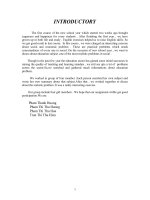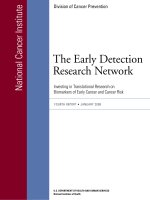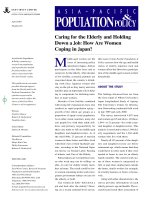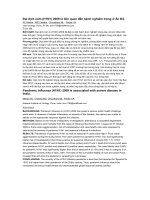project 2
Bạn đang xem bản rút gọn của tài liệu. Xem và tải ngay bản đầy đủ của tài liệu tại đây (742.87 KB, 5 trang )
<span class='text_page_counter'>(1)</span>The 2011 earthquake off the Pacific coast of Tōhoku was a magnitude 9.0 (Mw) undersea megathrust earthquake off the coast of Japan that occurred at 14:46 JST (05:46 UTC) on Friday 11 March 2011, with the epicentre approximately 70 kilometres (43 mi) east of the Oshika Peninsula of Tōhoku and the hypocenter at an underwater depth of approximately 30 km (19 mi). The earthquake is also often referred to in Japan as the Great East Japan earthquake and also known as the 2011 Tohoku earthquake, and the 3.11 earthquake. It was the most powerful earthquake ever recorded to have hit Japan, and the fourth most powerful earthquake in the world since modern recordkeeping began in 1900. The earthquake triggered powerful tsunami waves that reached heights of up to 40.5 metres (133 ft) in Miyako in Tōhoku's Iwate Prefecture, and which, in the Sendai area, travelled up to 10 km (6 mi) inland. The earthquake moved Honshu (the main island of Japan) 2.4 m (8 ft) east, shifted the Earth on its axis by estimates of between 10 cm (4 in) and 25 cm (10 in),and generated sound waves detected by the loworbiting GOCE satellite. On 10 March 2015, a Japanese National Police Agency report confirmed 15,894 deaths, 6,152 injured, and 2,562 people missing across twenty prefectures, as well as 228,863 people living away from their home in either temporary housing or due to permanent relocation. A 10 February 2014 agency report listed 127,290 buildings totally collapsed, with a further 272,788 buildings 'half collapsed', and another 747,989 buildings partially damaged. The earthquake and tsunami also caused extensive and severe structural damage in north-eastern Japan, including heavy damage to roads and railways as well as fires in many areas, and a dam collapse. Japanese Prime Minister Naoto Kan said, "In the 65 years after the end of World War II, this is the toughest and the most difficult crisis for Japan." Around 4.4 million households in northeastern Japan were left without electricity and 1.5 million without water. The tsunami caused nuclear accidents, primarily the level 7 meltdowns at three reactors in the Fukushima Daiichi Nuclear Power Plant complex, and the associated evacuation zones affecting hundreds of thousands of residents. Many electrical generators were taken down, and at least three nuclear reactors suffered explosions due to hydrogen gas that had built up within their outer containment buildings after cooling system failure resulting from the loss of electrical power. Residents within a 20 km (12 mi) radius of the Fukushima Daiichi Nuclear Power Plant and a 10 km (6.2 mi) radius of the Fukushima Daini Nuclear Power Plant were evacuated. Early estimates placed insured losses from the earthquake alone at US$14.5 to $34.6 billion. The Bank of Japan offered ¥15 trillion (US$183 billion) to the banking system on 14 March in an effort to normalize market conditions.[47] The World Bank's estimated economic cost was US$235 billion, making it the costliest natural disaster in world history. Japanese silently remember the past About 6 o'clock, 11th March 2012, nearly 300 volunteers gathered at rescue a beach in the city of Minamisanriku, Miyagi Prefecture, to pray together for the victims of the tsunami when dawn, NHK reported . In the city of about 20,000 people before the disaster struck, many people were killed while many houses were swept away by the tsunami a year ago. A 20-year-old college student from Tokyo say : "He has been praying and hoping that the Japanese people will never forget the tragedy 11/03/2011, to always remember it.
<span class='text_page_counter'>(2)</span> as a part of life their." In the city of Miyagi Prefecture Ishinomaki, the families of people killed and visited the grave and put flowers in memory of their loved ones. Keishitsu Ito, who survived the disaster, said the anniversary of the tsunami one year later his was a sad day. "My wife was swept away by the tsunami. I will put these flowers on her grave," his 80-year-old instrument, told AFP. "I was sad. I have no one to talk to anymore, even to quarrel". At Fukushima and Koriyama nearby cities, tens of thousands of people are expected to gather to take part in anti-nuclear protests, with calls for an end to use of atomic energy after the disaster at the power plant Fukushima I. A survey by NHK showed a third of families are living in temporary shelter said their income was reduced by half compared to before the disaster occurred. One in five people of working age have a person who is unemployed. The investigation also showed that a quarter of respondents said they rarely out of temporary quarters and feel isolated. Japan need desperately needs help..
<span class='text_page_counter'>(3)</span>
<span class='text_page_counter'>(4)</span>
<span class='text_page_counter'>(5)</span>
<span class='text_page_counter'>(6)</span>









